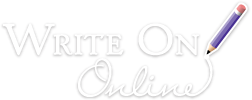Article review: “OK, Send Me A 2-Page Synopsis” by Jacqueline Lichtenburg
Your email pings. Yes! The agent responded to your query!
You hold your breath and click “open” to find the words you’ve been praying for: “Your novel concept sounds fascinating. Please submit the first 50 pages with a one-page synopsis.”
Fifty pages? No problem. One-page synopsis? Are you kidding me?
Now, take a deep breath. You can do this. I found a site to help.
Whether it’s a synopsis for your NaNoWriMo novel or for a script you’re eager to get produced, the sci-fi writer, Jacqueline Lichtenburg, wrote a wonderful post to aide you.
“You have to change your whole mentality and emotional involvement, your perspective and your values to create a synopsis of a work you have written.”
Lichtenburg speaks of the need to reboot your mind to switch from storytelling to summarization. The truth is, all those beautiful details you spent months getting into your story now have to come out to condense it down to its core. Your story will still need to sound compelling without them. In my opinion, that’s the test of the story’s foundation.
First, Lichtenburg has a candid discussion on researching the market you’re pitching to. Study it. Know who will read the synopsis, and make certain its geared toward their needs. Writing isn’t just art; it’s a business.
So, let’s get down to business! Before you start, you need to extract the following from your story:
a. The story in one sentence.
b. The plot in one sentence.
c. A 3-sentence paragraph that nails the beginning, middle, and end. At most 3 short paragraphs, 9 sentences maximum. This is the blurb that goes on the back of the paperback book.
Lichtenburg then goes into great detail of how to proceed. Truly, this article will give you all the tools you’ll need to complete your synopsis and improve your story as a whole.
In addition to providing a synopsis road-map, she includes links to other fantastic articles, such as Blake Snyder’s famous Beat Sheet.
With a one-page limit, how do you choose what to leave out and what to keep in? Think about the market, not about the story.
“What you leave OUT is the ‘interesting part.’ What you put in is the part that convinces your market to trust you to deliver THE SAME. They already know you think you can deliver DIFFERENT because you’re a creative artist. It’s THE SAME that is the mark of the professional artist.”
If your goal in writing is to sell your work, then you have no choice but to approach your submissions on a business level. The agent wants to represent an author who understands the market’s needs. Give them what they want, and it will sell.
Synopsis writing isn’t rocket science, but it will test the strength of your story. I challenge you to write one, even if the agent or producer hasn’t requested it. This year, I changed my approach and wrote a synopsis after outlining and before the completion of the first draft. The holes in my story POPPED! I was able to address them in draft one instead of having to hunt them down like rats in draft two.
This article was an enormous eye opener for me and one I’m delighted to recommend and share with all of you.
5 Purple Pencils
For more from Jeanne, read her article: Moving Write Along: Advice from the Experts – From Writer to Tweeter.
Tags: Face your Synopsis Fear Jacqueline Lichtenburg Jeanne Veillette Bowerman Novel Screenplay Synopsis








Comments are closed.
Wow, incredibly helpful post! Thank you!!
Thank you for pointing folks to my post on the synopsis.
I have in the back of my mind that I need to do a really thorough post on using the OUTLINE techniques. That word distracts most beginners from the real process because it’s the same word used in English courses regarding term papers and such. The two processes couldn’t be more opposite!